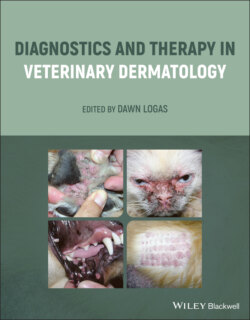Читать книгу Diagnostics and Therapy in Veterinary Dermatology - Группа авторов - Страница 39
General Method for a Dermatologic Examination
ОглавлениеOne common approach to the dermatologic examination is to begin at the nose and work one’s way caudally. All areas of the skin should be palpated and observed, taking care to inspect frequently overlooked locations. The nasal planum should be evaluated for moisture, normal cobblestone architecture, and changes in pigmentation (Figure 2.3). The oral cavity, lips, and eyelid margins should be checked for lesions such as erosions or ulcerations. A patient’s ability to blink should also be confirmed. The head should be lifted so the ventral neck can be evaluated completely, as this area is predisposed to thick skin folds that can contribute to fold dermatitis.
Figure 2.3 Depigmentation, erosion, erythema, and loss of normal cobblestone architecture on the nasal planum of a dog.
All four paws should be carefully examined. Both the dorsal and palmar/plantar surfaces of each paw, as well as all interdigital spaces, should be evaluated for signs such as erythema, exudate, erosions, or draining tracts. The nails themselves may be misshapen, brittle, broken, soft, or discolored. Hair may need to be gently moved away from nailbeds/claw folds to allow complete visualization. Examination of the paw pads for hyperkeratosis, ulcerations, and other changes should also be performed (Figure 2.4).
On the dorsal trunk, the general condition of the hair coat can be noted from a distance. Changes in texture, color, greasiness, or thickness can be observed. The hairs themselves should be parted to evaluate the skin surface for any papules, pustules, erythema, scaling, crusting, or other changes. The location of these changes should also be recorded (e.g. tail head, flank). The tail itself should also be evaluated, especially on the tip and in the area of the tail gland.
Ventrally, both axillae should be examined, and any erythema, moisture, or other lesions should be noted. The inguinal region and ventral chest are prone to lesions from bacterial infections that can be missed if the patient is not rolled over (Figure 2.5). This position can also be helpful for evaluating the perianal area, perivulvar fold, and prepuce. Nipples and mammary glands should be examined for subtle signs such as enlargement, discharge, or crusting.
Otoscopic evaluation should be performed in every patient, but can be delayed until the end of the exam as it can distress some animals. The pinnae themselves should be examined, with a focus on the concave aspect as well as the vertical canal. Lesions can be subtle in some cases, such as crusting on the pinnal margins associated with vasculitis (Figure 2.6). A handheld or video otoscope will usually allow visualization of the horizontal canal and tympanic membrane.
Figure 2.4 Hyperkeratosis, crusting, and erythema of the paw pads of a dog.
Figure 2.5 Epidermal collarettes, pustules, erythema, and hyperpigmentation on the abdomen of a dog with a bacterial pyoderma. These lesions were not visible until the dog was lifted for evaluation of the ventrum.
Figure 2.6 Alopecia, crusting, and hyperpigmentation along the pinnal margin in a dog with vasculitis.
